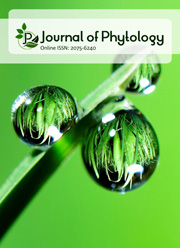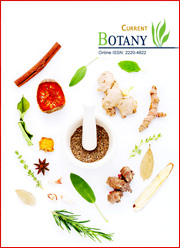Мicropropagation protocol for Mongolian rare shrub Lycium truncatum Y.C. Wang
DOI:
https://doi.org/10.25081/jp.2024.v16.9212Keywords:
Lycium truncatum, Nodal segments, DKW medium, Micropropagation, AcclimatizationAbstract
In this study, micropropagation protocol for the Mongolian rare shrub Lycium truncatum L. has been developed through axenical seed germination. There are successful micropropagation procedures for some Lycium species; nonetheless, L. truncatum requires both in-vitro and ex-vitro optimization.The 4-week-old sterile seedlings with spontaneous root formation, cultivated in full-strength hormone-free MS media were utilized as initial explants for in vitro culture. The highest shoot proliferation (4.6 shoots/explant) was achieved on Driver and Kuniyuki Walnut medium (DKW) supplemented with 2 mg/L kinetin (KIN) and 0.1 mg/L 1-naphtaleneacetic acid (NAA) combination. The proliferating shoots on the half-strength MS media supplemented with 0.1mg/L NAA displayed robust root formation. The rooted plantlets were acclimated in sterile soil in a pot and cultivated at room temperature for 2-3 months with a high survival rate of more than 90% before transferring to the greenhouse.
Downloads
References
Baasanmunkh, S., Urgamal, M., Oyuntsetseg, B., Sukhorukov, A. P., Tsegmed, Z., Son, D. C., Erst, A., Oyundelger, K., Kechaykin, A. A., Norris, J., Kosachev, P., Ma, J.-S., Chang, K. S., & Choi, H. J. (2022). Flora of Mongolia: annotated checklist of native vascular plants. PhytoKeys, 192, 63-169. https://doi: 10.3897/phytokeys.192.79702
Conghui, W., Tiejun, W., Fang, G., Caiyun, Q., Shigang, C., Jufeng, C., & Jing, T. (2019). Micropropagation of Lycium ruthenicum Murr. Forest Engineering, 35, 32-36.
de Oliveira Prudente, D., de Souza, L. B., Paiva, R., Domiciano,D., de Carvalho, P. A., & Nery, F. C. (2019). Goji berry (Lycium barbarum L.) in vitro multiplication improved by light-emitting diodes (LEDs) and 6-benzylaminopurine. In Vitro Cellular & Developmental Biology- Plant, 55, 258-264. https://doi.org/10.1007/s11627-019-09970-w
Dimitrova, V., Ivanova, K., Petrov, P., Anev, S., Tzvetkova, N., Georgieva, T., & Markovska, Y. (2017). Influence of salt stress on leaf morphology and photosynthetic gas exchange in two lycium species. Proceedings of the Bulgarian Academy of Sciences, 70(3), 367-374.
Driver, J. A., & Kuniyuki, A. H. (1984). In vitro propagation of Paradox walnut rootstock. HortScience, 19(4), 507-509. https://doi.org/10.21273/HORTSCI.19.4.507
Fira, A., Joshee, N., Cristea, V., Simu, M., Monica, H., Pamfil, D., & Clapa, D. (2016). Optimization of Micropropagation Protocol for Goji Berry (Lycium barbarum L.). Bulletin of University of Agricultural Sciences and Veterinary Medicine Cluj-Napoca. Horticulture,73(2), 141-150. https://doi.org/10.15835/buasvmcn-hort:12177
Frabetti, M., Gutiérrez-Pesce, P., Mendoza-deGyves, E., & Rugini, E. (2009). Micropropagation of Teucrium fruticans L., an ornamental and medicinal plant. In Vitro Cellular & Developmental Biology – Plant, 45, 129-134.https://doi.org/10.1007/s11627-009-9192-z
Gao, Y., Wang, Q.-M., An, Q., Cui, J., Zhou, Y., Qi, X., Zhang, L., & Li, L. (2021). A novel micropropagation of Lycium ruthenicum and epigenetic fidelity assessment of three types of micropropagated plants in vitro and ex vitro. PLoS One,16(2), e0247666. https://doi.org/10.1371/journal.pone.0247666
Gong, H., Rehman, F., Ma, Yu., Biao, A., Zeng, S., Yang, T., Huang, J., Li, Z., Wu, D., & Wang, Y. (2022). Germplasm Resources and Strategy for Genetic Breeding of Lycium Species: A Review. Frontiers in Plant Science, 13, 802936. https://doi.org/10.3389/fpls.2022.802936
Hazarika, B. N. (2003). Acclimatization of tissue-cultured plants. Current Science, 85(12), 1704-1712.
Hu, Z., Guo, G.-Q., Zhao, D.-L., Li, L.-H., & Zheng, G.-C. (2001). Shoot Regeneration from Cultured Leaf Explants of Lycium barbarum and Agrobacterium-Mediated Transformation1. Russian Journal of Plant Physiology, 48, 453-458. https://doi.org/10.1023/A:1016791027554
Hu, Z., Wu, Y.-R., Li, W., & Gao, H.-H. (2006). Factors affecting Agrobacterium tumefaciens-mediated genetic transformation of Lycium barbarum L. In Vitro Cellular & Developmental Biology-Plant, 42, 461-466. https://doi.org/10.1079/IVP2006796
Hu, Z., Yang, J., Guo, G., & Zheng, G. (2002). High-efficiency transformation of Lycium barbarum mediated by Agrobacterium tumefaciens and transgenic plant regeneration via somatic embryogenesis. Plant Cell Reports, 21, 233-237. https://doi.org/10.1007/s00299-002-0462-z
Kairong, C., Gengsheng, X., Lin, Q., Xinmin, L., & Yafu, W. (1999). The analysis of differential gene expression in early somatic embryogenesis on Lycium barbarum. Plant Cell, Tissue and Organ Culture, 59, 169-174. https://doi.org/10.1023/A:1006311628358
Lloyd, G., & McCown, B. (1980). Commercially-feasible micropropagation of mountain laurel, Kalmia latifolia, by use of shoot-tip culture. Combined Proceedings, International Plant Propagators' Society, 30, 421-427.
Murashige, T., & Skoog, F. (1962). A revised medium for rapid growth and bio assays with tobacco tissue cultures. Physiologia plantarum, 15(3), 473-497. https://doi.org/10.1111/j.1399-3054.1962.tb08052.x
Oyuntsetseg, B., Nyambayar, D., Dulamsuren, C., &Jamsran, T. (2014). Conspectus of the vascular plants of Mongolia. Admon Printing, Ulaanbaatar.
Rugini, E. (1992). Involvement of polyamines in auxin and Agrobacteriumrhizogenes-induced rooting of fruit trees in vitro. Journal of the American Society for Horticultural Science, 117(3), 532-553. https://doi.org/10.21273/JASHS.117.3.532
Ruta, C., De Mastro, G., Ancona, S., Tagarelli, A., De Cillis, F., Benelli, C., & Lambardi, M. (2020). Large-scale plant production of Lycium barbarum L. by liquid culture in temporary immersion system and possible application to the synthesis of bioactive substance. Plants, 9(7), 844. https://doi.org/10.3390/plants9070844
Silvestri, C., Sabbatini, G., Marangelli, F., Rugini, E., & Cristofori, V. (2018). Micropropagation and Ex Vitro Rooting of Wolfberry. HortScience,53, 1494-1499. https://doi.org/10.21273/HORTSCI13423-18
Yao, R., Heinrich, M., & Weckerle, C. S. (2018). The genus Lycium as food and medicine: a botanical, ethnobotanical and historical review. Journal of Ethnopharmacology, 212, 50-66. https://doi.org/10.1016/j.jep.2017.10.010
Zhurba, M. Y., Klymenko, S. V., & Szot, I. (2021). Variability of morphometric traits of seeds of different genotypes of Lycium spp. Plant Varieties Studying and Protection, 17(1), 5-13. https://doi.org/10.21498/2518-1017.17.1.2021.228198
Zhurba, M. Y., Vergun, O., Klymenko, S., & Szot, I. (2021).Biochemical characterization of fruits of Lycium spp. in Ukraine. Regulatory Mechanisms in Biosystems, 12(1), 71-77. https://doi.org/10.15421/022111
Published
How to Cite
Issue
Section
Copyright (c) 2024 D. Erdenetuul, M. Selenge, U. Bolortuya, B. Uyanga, B. Altantsetseg, Kalaiselvi Senthil, Yu. Oyunbileg

This work is licensed under a Creative Commons Attribution 4.0 International License.





 .
.